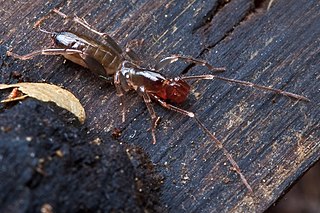
Schizomida, also known as sprickets or short-tailed whip-scorpions, is an order of arachnids, generally less than 5 millimetres (0.20 in) in length. The order is not yet widely studied. E. O. Wilson has identified schizomids as among the "groups of organisms that desperately need experts to work on them."
Draculoides bramstokeri is a small, troglobite, Australian arachnid. Often mistaken for a spider, D. bramstokeri is a schizomid — a small, soil-dwelling invertebrate that walks on six legs and uses two modified front legs as feelers. It uses large fang-like pedipalps, or pincers, to grasp invertebrate prey and crunch it into pieces before sucking out the juices. Named for this method of dispatching victims and after Bram Stoker, the author of Dracula.
Draculoides vinei is a species of schizomid arachnids in the Hubbardiidae family. It is endemic to Australia. It was described in 1988 by Australian arachnologist Mark Harvey. The specific epithet vinei honours Brian Vine, a student of the species’ biology.
Draculoides anachoretus is a species of schizomid arachnids in the Hubbardiidae family. It is endemic to Australia. It was described in 2008 by Australian arachnologists Mark Harvey, Oliver Berry, Karen Edward and Garth Humphreys. The specific epithet anachoretus, from Greek anachoretes, refers to the species’ subterranean habitat.
Draculoides bythius is a species of schizomid arachnids in the Hubbardiidae family. It is endemic to Australia. It was described in 2008 by Australian arachnologists Mark Harvey, Oliver Berry, Karen Edward and Garth Humphreys. The specific epithet bythius, from Greek bythios, refers to the species’ subterranean habitat.
Draculoides gnophicola is a species of schizomid arachnids in the Hubbardiidae family. It is endemic to Australia. It was described in 2008 by Australian arachnologists Mark Harvey, Oliver Berry, Karen Edward and Garth Humphreys. The specific epithet gnophicola, from Greek gnophos (‘darkness’) and -cola (‘-dweller’), refers to the species’ subterranean habitat.
Draculoides kryptus is a species of schizomid arachnids in the Hubbardiidae family. It is endemic to Australia. It was described in 2008 by Australian arachnologists Mark Harvey, Oliver Berry, Karen Edward and Garth Humphreys. The specific epithet kryptus, from Greek kryptos (‘hidden’), refers to the species’ subterranean habitat.
Draculoides mesozeirus is a species of schizomid arachnids in the Hubbardiidae family. It is endemic to Australia. It was described in 2008 by Australian arachnologists Mark Harvey, Oliver Berry, Karen Edward and Garth Humphreys. The specific epithet mesozeirus, from Greek mesos (‘middle’) and zeira (‘robe’), refers to the type locality.
Draculoides neoanthropus is a species of schizomid arachnids in the Hubbardiidae family. It is endemic to Australia. It was described in 2008 by Australian arachnologists Mark Harvey, Oliver Berry, Karen Edward and Garth Humphreys. The specific epithet mesozeirus, from Greek neo (‘new’) and anthropos (‘man’), refers to the type locality.
Draculoides immortalis is a species of schizomid arachnids in the Hubbardiidae family. It is endemic to Australia. It was described in 2020 by Australian arachnologists Kym Abrams and Mark Harvey.
Draculoides karenbassettae is a species of schizomid arachnids in the Hubbardiidae family. It is endemic to Australia. It was described in 2020 by Australian arachnologists Kym Abrams and Mark Harvey.
Draculoides nosferatu is a species of schizomid arachnids in the Hubbardiidae family. It is endemic to Australia. It was described in 2020 by Australian arachnologists Kym Abrams and Mark Harvey.
Draculoides warramboo is a species of schizomid arachnids in the Hubbardiidae family. It is endemic to Australia. It was described in 2020 by Australian arachnologists Kym Abrams and Mark Harvey.
Draculoides affinis is a species of schizomid arachnids in the Hubbardiidae family. It is endemic to Australia. It was described in 2018 by Australian arachnologists Volker Framenau, Zoë Hamilton, Terrie Finston, Garth Humphreys, Kym Abrams, Joel Huey and Mark Harvey. The specific epithet affinis is Latin for ‘related to’ or ‘neighbouring’, with reference to its similarity to other species in the genus.
Draculoides catho is a species of schizomid arachnids in the Hubbardiidae family. It is endemic to Australia. It was described in 2018 by Australian arachnologists Volker Framenau, Zoë Hamilton, Terrie Finston, Garth Humphreys, Kym Abrams, Joel Huey and Mark Harvey. The specific epithet catho refers to the type locality.
Draculoides celatus is a species of schizomid arachnids in the Hubbardiidae family. It is endemic to Australia. It was described in 2018 by Australian arachnologists Volker Framenau, Zoë Hamilton, Terrie Finston, Garth Humphreys, Kym Abrams, Joel Huey and Mark Harvey. The specific epithet celatus refers to the discovery of the species only by molecular analysis.
Draculoides cochranus is a species of schizomid arachnids in the Hubbardiidae family. It is endemic to Australia. It was described in 2018 by Australian arachnologists Volker Framenau, Zoë Hamilton, Terrie Finston, Garth Humphreys, Kym Abrams, Joel Huey and Mark Harvey. The specific epithet cochranus refers to the type locality.
Draculoides confusus is a species of schizomid arachnids in the Hubbardiidae family. It is endemic to Australia. It was described in 2018 by Australian arachnologists Volker Framenau, Zoë Hamilton, Terrie Finston, Garth Humphreys, Kym Abrams, Joel Huey and Mark Harvey. The specific epithet confusus refers to the shared diagnostic characters of Draculoides and Paradraculoides.
Draculoides trinity is a species of schizomid arachnids in the Hubbardiidae family. It is endemic to Australia. It was described in 2018 by Australian arachnologists Volker Framenau, Zoë Hamilton, Terrie Finston, Garth Humphreys, Kym Abrams, Joel Huey and Mark Harvey. The specific epithet trinity refers to the type locality.
Draculoides obrutus is a species of schizomid arachnids in the Hubbardiidae family. It is endemic to Australia. It was described in 2018 by Australian arachnologists Volker Framenau, Zoë Hamilton, Terrie Finston, Garth Humphreys, Kym Abrams, Joel Huey and Mark Harvey. The specific epithet obrutus refers to the species only being discovered through molecular analysis.
